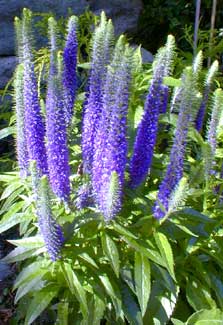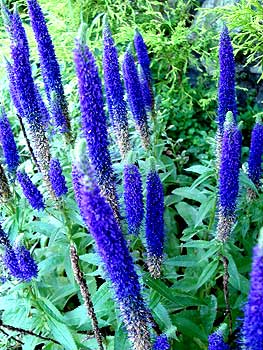
"Royal Candles"
Dwarf Blue Spiked Speedwell
"Down blue-spiked veronica
light flowed in rivulets
over the humps of the honeybees."
-Stanley Kunitz,
b.1905
b.1905
The hybrid dwarf blue speedwell Veronica spicata x longifolia 'Glory' is also sold under the trademark name "Royal Candles." It is a particularly compact speedwell, its spike-racemes of blue florets standing very upright to no more than a foot or eighteen inches height, above a much shorter clump of basal foliage.
 Its rich dark violet-blue flowers begin late spring (June) & continue throughout summer, up to as late as October. To keep it flowering may require shearing off old fading spikes from time to time.
Its rich dark violet-blue flowers begin late spring (June) & continue throughout summer, up to as late as October. To keep it flowering may require shearing off old fading spikes from time to time.This cultivar was developed in Great Britain by Heather Philpott of Plant Haven Nursery, who used as its primary parent an earlier cultivar 'Sunny Border Blue' developed by Sunny Border Nurseries of Connecticut. 'Sunny Border Blue' was awarded Perennial Plant of the Year, from the Perennial Plant Association, in 1993; it rapidly became one of the standard cultivars. 'Royal Candles' was in turn Plant of the Year for 2001. It has the same crinkly leaves & vibrant almost luminescent blue-violet blooms, but remains slightly smaller than 'Sunny Border Blue.'
Division of clumps can be done either spring or fall. It can also be propagated from summer cuttings. It thrives in zones 5 through 8, & possibly down to zone 3 or even 2. It does pretty well in our naturally acidic soils, but probably would prefer neutral or slightly alkaline soil, so can stand a little lime feed at the beginning of each spring, or a piece of blackboard chalk inserted into the center of its roots once a year.
At risk of rotting in poorly drained soils, it likes a rockery ledge or other sharply draining location. It nevertheless wants regular watering to look its best. In conditions it loves, it becomes a vibrant groundcover attractive to butterflies & bees.
Veronica suffered twelve years from severe menstrual hemorrhaging, until she touched the fringe of Jesus' garment & was miraculously cured [Matthew 9:20-22; Mark 5:25; Luke 8:43]. In the Diatessaron of Tatian, she was said to have impoverished herself seeking cures from physicians over a period of four years, & was on the verge of death at the time when she was healed by touching Jesus's garment. She touched his hem because she was too weak to reach any higher.
It was forbidden that bleeding women touch a rabbi, yet in the gospel accounts, Jesus gave no indication that he thought such a law held merit. Iraneaus reported the Gnostic belief that Veronica was an avatar of Sophia the twelfth & last-born of the Light Aeons; hence Veronica suffered for eleven years & was released from the Passion in the twelfth [Against Heresies 2:1-2].
When Jesus was on trial for his life, Veronica came forth to give evidence of his divinity, as recounted in the Gospel of Nicodemus & the Letter of Pilate. In Bartholomew's Book of the Resurrection, Veronica was named among the women who went to Christ's tomb. She raised a statue in commemoration of her miraculous cure, & traveled to Rome soonafter, where she preached the new Christianity.
Another legend supposes she became the wife of Zacchaeus the superintendent of tax collectors [Luke 19:1-10], with whom she preached in France after the resurrection. If this marriage is credited, then after Jesus cured her she must have gone to live in Jericho & met Zacchaeus at this time [19:1]. When Jesus traveled there, he naturally stayed in her house [19:5]. This would explain why Zacchaeus was so eager to see Jesus [19:3], was already known to Jesus though they had not formerly met [19:5], & was greeted joyously by Zacchaeus [19:6], due to what Veronica had told him.
Veronica's name was by some translated "True Icon.' In the Latin Avenging of the Savior & other apocryphal works, she was said to have owned the only portrait of Jesus taken from life. On Jesus's painful march toward Calvary, Veronica stepped out of the crowd to wipe sweat from his brow, later to discover that his visage was imprinted on the scarf.
Alternatively, some held that the portrait was painted by John the Evangelist, either from life or from memory, & Veronica brought it to Rome, where she cured Emperor Tiberius of severe illness by having him gaze upon the image. An actual painting to which these & similar legends were attached served for a while as a Palladium in the Roman army.
Eusebius credibly reports that Veronica's house in Paneas was a pilgrimage site, which effectively sweeps away the majority of the stories that surround her, for if she existed at all she seems to have been of a wealthy but obscure family randomly healed by Jesus. In front of her house in Paneas were two brazen statues, one of Veronica, one of Jesus. These were believed to have been commissioned by Veronica, so that both likenesses were true.
In front of the statue of Veronica, in the garden of her house, grew a mystic herb credited with healing powers [Ecclesiastical History 7:8]. The herb was associated with her statue & not with Jesus's because certain traits of a Goddess were imposed on Veronica, the Earthmother being generally associated with herb lore & healing magic.